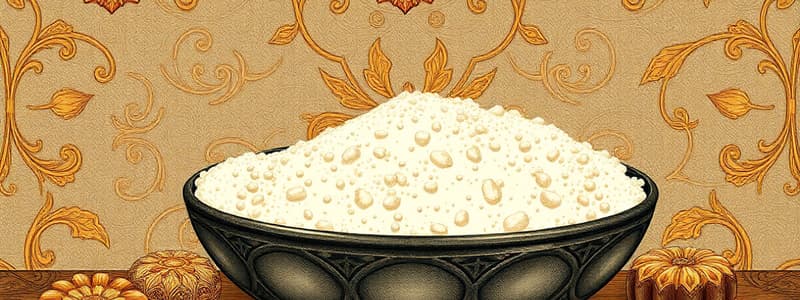Podcast
Questions and Answers
If a baker wants to produce a loaf of bread with a strong, elastic structure, which type of flour should they choose?
If a baker wants to produce a loaf of bread with a strong, elastic structure, which type of flour should they choose?
- Cake flour, due to its low protein content.
- Soft flour, to ensure a fine and delicate crumb structure.
- All-purpose flour, for its balanced gluten development.
- Bread flour, because of its high gluten content. (correct)
A chef needs a flour that will provide a tender and delicate texture in cakes. Which of the following flours would be the MOST suitable?
A chef needs a flour that will provide a tender and delicate texture in cakes. Which of the following flours would be the MOST suitable?
- Hard flour
- All-purpose flour
- Cake flour (correct)
- Bread flour
A food manufacturer aims to create a versatile product suitable for a wide range of baking applications, from bread to pastries. Which type of flour would be the MOST appropriate choice?
A food manufacturer aims to create a versatile product suitable for a wide range of baking applications, from bread to pastries. Which type of flour would be the MOST appropriate choice?
- All-purpose flour (correct)
- Bread flour
- Pastry flour
- Cake flour
In a scenario where a recipe requires a flour with moderate gluten development—stronger than what cake flour offers but not as strong as bread flour—which of the following would be the BEST substitute if the recipe calls for "General Purpose Flour"?
In a scenario where a recipe requires a flour with moderate gluten development—stronger than what cake flour offers but not as strong as bread flour—which of the following would be the BEST substitute if the recipe calls for "General Purpose Flour"?
Besides providing structure and texture, what other function does flour serve in baked goods?
Besides providing structure and texture, what other function does flour serve in baked goods?
Flashcards
Flour
Flour
A finely ground meal from cereal grains or root crops.
Hard Flour
Hard Flour
Flour high in gluten, with 12-14% protein content, ideal for bread.
Cake Flour
Cake Flour
Low-gluten flour (7-9% protein) made from soft wheat, perfect for cakes.
All-Purpose Flour
All-Purpose Flour
Signup and view all the flashcards
Uses of Flour
Uses of Flour
Signup and view all the flashcards
Study Notes
Flour Production
- Flour is a finely ground meal made from cereal grains or root crops.
- Wheat flour is the most common type.
- Other sources include rye, barley, maize, rice, potatoes, etc.
- Flour protein mixes with water to form gluten.
- Higher protein content results in stronger gluten.
Flour Types
- Flour is categorized as hard or soft.
- Hard flour (bread flour):
- High gluten content (12-14% protein).
- Strongest gluten strength.
- Made from hard wheat.
- Ideal for breadmaking due to its ability to create rise and structure.
- All-purpose flour:
- Blend of hard and soft wheat flours.
- Medium gluten content (10-11% protein).
- Also known as General Purpose or family flour.
- Soft flour:
- Lower gluten content.
- Produces finer textures.
- Cake flour: Lowest gluten content (7-9% protein), soft wheat, used for delicate textures in cakes and cookies.
- Pastry flour: Slightly higher gluten than cake flour, also made from soft wheat
Flour Applications
- Baked goods: Provides structure, texture, and color to baked products.
- Nutrition: Adds nutritive value to baked products.
- Thickening: Used as a thickening agent.
- Binding: Acts as a binder in food products.
- Stiffening: Used as a stiffening agent in laundry.
Studying That Suits You
Use AI to generate personalized quizzes and flashcards to suit your learning preferences.




